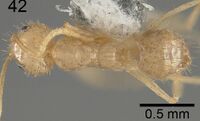Nylanderia lucayana
| Nylanderia lucayana | |
|---|---|

| |
| Scientific classification | |
| Kingdom: | Animalia |
| Phylum: | Arthropoda |
| Class: | Insecta |
| Order: | Hymenoptera |
| Family: | Formicidae |
| Subfamily: | Formicinae |
| Tribe: | Lasiini |
| Genus: | Nylanderia |
| Species: | N. lucayana |
| Binomial name | |
| Nylanderia lucayana LaPolla & Kallal, 2019 | |
The type material was found on North Andros Island, Bahamas under a rock on the bank of a creek.
Identification
Pale-yellow with REL: 19–23 and SI2: 15–19.
Compare with: Nylanderia guatemalensis.
Workers of Nylanderia lucayana and N. guatemalensis are very similar but can be best separated another using eye size. The eye of N. lucayana is generally smaller and it has a relative eye index 19–23. In N. guatemalensis, the relative eye index is above 21, with most specimens in the mid-20s and some approaching 30. The SI2 index also effectively separates the two species (measured range in N. lucayana: 15–19; measured range in N. guatemalensis: 18–26). There is also a color difference between the two but it is difficult to appreciate it until one has looked at many specimens of N. guatemalensis. Nyladeria guatemalensis is never as pale yellow as seen in N. lucayana. Finally, N. lucayana is putatively an endemic to the Lucayan Archipelago so it is likely only in this area that separating N. guatemalensis and N. lucayana is necessary. Gotzek et al. (2012) clearly show this species (listed as Nylanderia n.sp. 83) to be quite distinct phylogenetically from N. guatemalensis (Gotzek et al. 2012 and unpublished data).
Keys including this Species
Distribution
Distribution based on Regional Taxon Lists
Neotropical Region: Bahamas (type locality).
Distribution based on AntMaps
Distribution based on AntWeb specimens
Check data from AntWeb
Countries Occupied
| Number of countries occupied by this species based on AntWiki Regional Taxon Lists. In general, fewer countries occupied indicates a narrower range, while more countries indicates a more widespread species. |

|
Estimated Abundance
| Relative abundance based on number of AntMaps records per species (this species within the purple bar). Fewer records (to the left) indicates a less abundant/encountered species while more records (to the right) indicates more abundant/encountered species. |

|
Biology
Castes
Nomenclature
The following information is derived from Barry Bolton's Online Catalogue of the Ants of the World.
- lucayana. Nylanderia lucayana LaPolla & Kallal, 2019: 420, figs. 40-42 (w.) BAHAMAS.
Unless otherwise noted the text for the remainder of this section is reported from the publication that includes the original description.
Description
Worker
(n=4): TL: 2.10–2.20; HW: 0.49–0.55; HL: 0.59–0.65; EL: 0.12–0.14; SL: 0.73– 0.77; WL: 0.67–0.74; GL: 0.76–0.85. SMC: 22–32; PMC: 4–3; MMC: 3–4. indices: CI: 82–89; REL: 19–23; SI: 134–151; SI2: 15–19.
Head: sides of head in full face view nearly parallel; posterolateral corners rounded; posterior margin straight and slightly emarginate medially; anterior clypeal margin emarginate; ocelli absent; eye well-developed. Mesosoma: in lateral view, pronotum convex; anterior margin of mesonotum more or less even with posterior pronotal margin; metanotal area without a short flat area before spiracle; dorsal face of propodeum slightly convex; dorsal face of propodeum lower than dorsal face of mesonotum in lateral view. Color and pilosity: pale yellow, gaster sometimes slightly darker yellow; macrosetae across body yellow to white, some darker brownish-yellow towards bases; cephalic pubescence sparse; mesosoma with pubescence dorsally on pronotum and mesonotum; gastral tergites I & II with dense pubescence dorsally.
Type Material
Holotype worker, BAHAMAS: North Andros Island, access road to Stafford Creek south of bridge, 12 Nov 1996, under rock on bank, M. Deyrup & L. Davis (National Museum of Natural History); 11 paratype workers same locality as holotype (specimens are from the same nest as holotype) (NMNH & Museum of Comparative Zoology).
Etymology
Species epithet is a toponym relating to the Lucayan Archipelago where this species is found.
References
- LaPolla, J.S., Kallal, R.J. 2019. Nylanderia of the World Part III: Nylanderia in the West Indies. Zootaxa 4658 (3): 401–451 (doi:10.11646/zootaxa.4658.3.1).
- Williams, J.L., Zhang, Y.M., LaPolla, J.S., Schultz, T.R., Lucky, A. 2022. Phylogenetic delimitation of morphologically cryptic species in globetrotting Nylanderia (Hymenoptera: Formicidae) species complexes. Insect Systematics and Diversity 6 (1): 10:1-15 (doi:10.1093/isd/iaxb027).
- Williams, J.L., Zhang, Y.M., Lloyd, M.W., LaPolla, J.S., Schultz, T.R., Lucky, A. 2020. Global domination by crazy ants: phylogenomics reveals biogeographical history and invasive species relationships in the genus Nylanderia (Hymenoptera: Formicidae). Systematic Entomology 45, 730–744 (doi:10.1111/syen.12423).
References based on Global Ant Biodiversity Informatics
- LaPolla J. S., and R. J. Kallal. 2019. Nylanderia of the World Part III: Nylanderia in the West Indies. Zootaxa 4658: 401-451.

